A viable option for people who want to grow their own food at home is vertical gardening, where multiple plants can be grown in a very small space by essentially stacking them on top of each other.
While many people love having fresh produce in their house, many of those same people don’t have the space or the time to grow that produce themselves. For people who live in cities or don’t have a large plot of land, Vertical gardening is your best option.
Vertical gardening is where plants are grown stacked above one another or are trained to grow upwards. Hanging planters, stackable systems, and specially designed planters can be used. It can be used both indoors and outdoors and is a great option for those with limited space.
If you love having fresh produce at home and want to save a fortune on buying it every week at the grocery store, vertical gardening is your solution. In this article, you’ll learn about several different systems of vertical gardening, including hydroponic, aeroponic, and traditional systems.
Best Vertical Garden System – Our Pick
To help our readers that are short on time here’s our top pick of vertical garden systems. Not only is it the easiest system to grow healthy and nutritious fruit and vegetables at home but it also offers a 12 month interest free purchase plan to get you started growing fast.
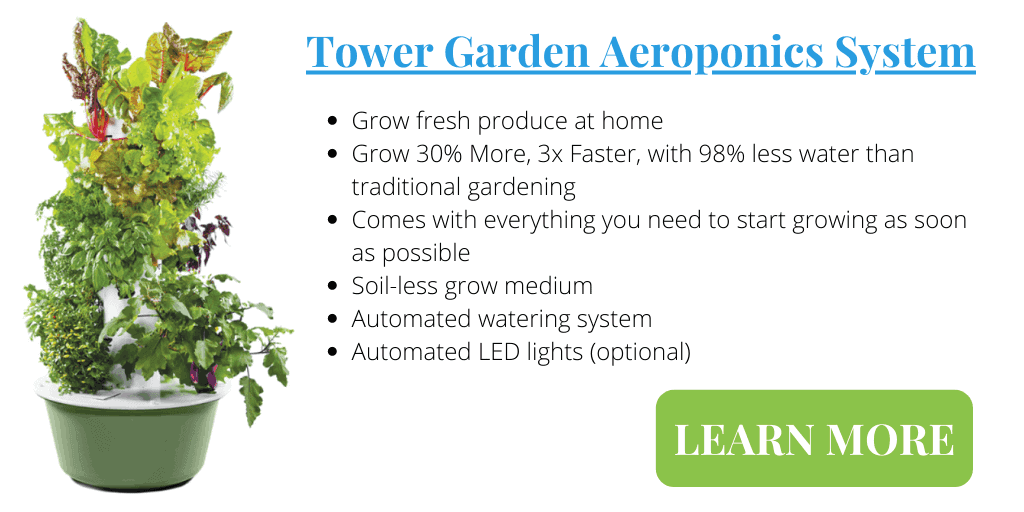
What is Vertical Gardening?
Most home vertical gardening systems use a UV stabilized food grade plastic tower to grow a large variety and number of vegetables, herbs, and flowers. Depending on the system being used, they are able to be grown indoors or outdoors and require very little square footage.
In a similar way to a skyscraper, which adds space by building up instead of out, a vertical gardening tower may reach five feet high and some models can support up to 50 plants! It’s particularly well-suited to urban gardening and farming because one tower requires such little space.
Traditional gardening, on the other hand, requires a large plot of land, strenuous weeding, and is only possible during certain times of the year. Plants in a garden require a great deal more space to grow and spread out than in vertical gardening systems, and they’re more subjected to the elements as well.
Another problem with traditional gardening is weeds and insects, which require continuous care. Vertical systems require much less daily maintenance. But vertical gardens do have other factors that need to be considered. Learn more in my article, How to Protect Your Vertical Garden.
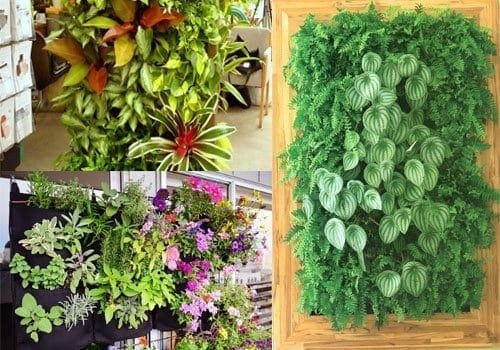
Vertical gardening also has important impacts on the agricultural industry. Although large-scale vertical farming systems are expensive to install at first, they promise higher yields in less time, and take up less space.
As the world’s population continues to grow and the demand on farmers grows as well, it’s critical to be able to grow more crops in less time while using less space and resources. Vertical gardening offers a way to keep the agricultural industry in line with growing demand trends, and indeed, implementations of it have already resulted in an increased capacity to produce the world’s food.
How Much Space Do You Need?
The space required for traditional gardening is perhaps one of the most compelling reasons to consider vertical gardening, especially for urban gardeners. City-dwellers have been dependent on outside sources of fresh produce for years, and the only possible option they’ve had has been community gardens where they don’t have a lot of control over what happens to their crops.
Enter vertical gardening systems, which only take up a few square feet of space and can be placed in an apartment, a small room, an office, or on a small outdoor balcony. It offers a number of benefits to urban gardeners who want to grow their own produce, eat healthier, and save some money.
There are three main vertical gardening systems that use different methods for growing plants. These three systems will be described in much more detail with examples further below including the following:
- Hydroponic Vertical Systems
- Aeroponic Vertical Systems
- Traditional Vertical Systems
These systems differ in the way plants are grown and how they get nutrients, and each system offers a variety of benefits and different experiences in growing your own fresh produce. Keep reading to see some of the many benefits vertical gardening as a whole can provide, as well as some of the nuances and differences between each system.
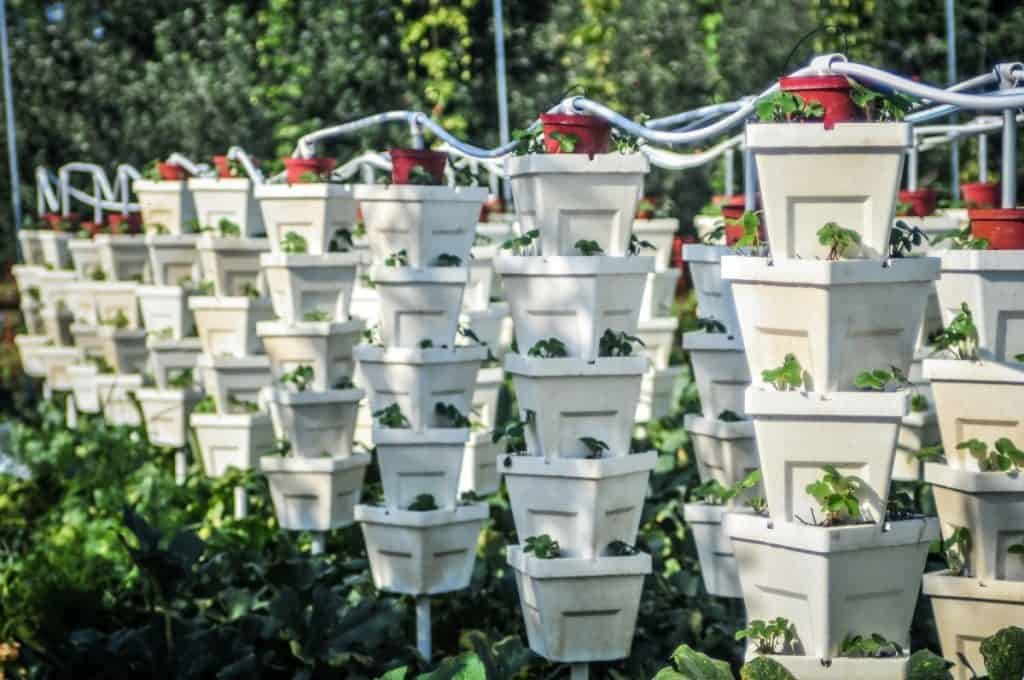
Benefits of Vertical Gardening
Vertical gardening has many benefits that almost anyone can enjoy. Here are just a few of those benefits:
- Cost savings – buying fresh produce at the store can be expensive, but growing it yourself with a vertical gardening tower can save you hundreds of dollars per year.
- Simple for beginners – even if you have no gardening experience or skill, vertical gardening is simple enough that anyone can grow their own vegetables, herbs, and flowers at their own home.
- Space-saving – vertical gardening doesn’t require a huge patch of soil to grow; it efficiently uses vertical space to grow multiple plants in only a couple of square feet. There are systems that can be grown indoors and ones that can be placed on a small patch of land outdoors.
- Water efficient – vertical gardening systems use water very efficiently so that less of it is required for a greater number of plants than in traditional gardening. They lessen the load on agricultural production which lessens the strain on our water supply.
- Environmentally friendly – Transportation of food from farms to supermarkets is one of the largest agricultural polluters. Growing at home not only reduces this pollution but the plants you grow filter carbon dioxide out of the atmosphere as well.
- Healthier produce – since you know exactly what is being used to grow your produce, you can be sure there aren’t any pesticides or harmful chemicals in your food. And because you pick only what you need your produce will be delicious and nutritious.
- Great for learning – Vertical farming at home is something fun that the whole family will enjoy. Learning how food is produced and being involved in the process from start to finish is a great experience for adults and children.
As you can see, vertical gardening is filled with potential benefits for anyone willing to give it a try. The systems are relatively inexpensive and will pay for themselves over time. Hydroponic systems are typically more expensive upfront than traditional gardens, but they also require less care and maintenance and typically have higher yields in a shorter time.
If you are wondering how much it costs to set up a vertical garden, check out my article, How Much Does A Vertical Garden Cost?
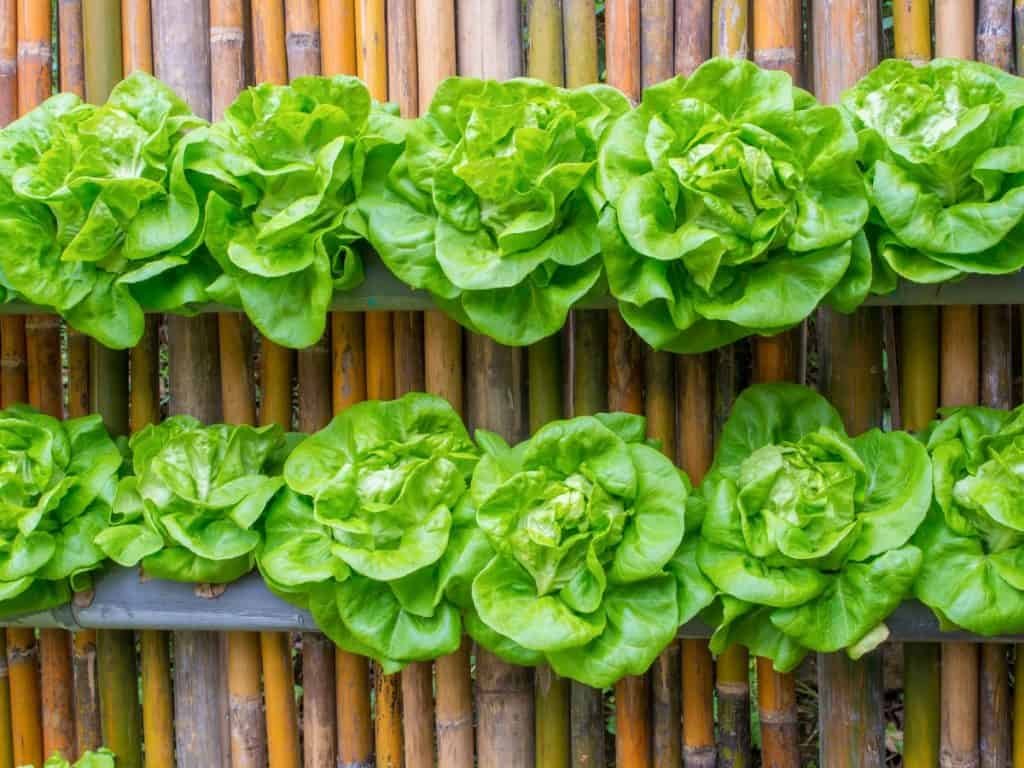
Vertical Gardening Systems
As mentioned above, there are three main vertical gardening systems. Choosing the right system for you depends on your own personal situation as well as the amount of work and resources you want to put into your vertical garden.
Essentially, the main difference between each of these types of systems is the way the plants are grown and get their nutrients.
In hydroponic systems, plants are supported in a hydroponic medium like rockwool or dried coconut husks. Nutrient rich water covers the roots and root ball providing the minerals they need for healthy growth. Oxygen gets added into the water through a bubbling system.
Aeroponic systems are similar to hydroponics, except the roots are suspended in air and nutrient-rich solution is sprayed on the roots. Having oxygen around the roots allows them to absorb the minerals more efficiently and prevents root rot. Aeroponics constantly recycles the water in the system reducing consumption by over 90%.
More traditional vertical gardening systems use soil and compost like in typical gardening. Learn more about the best soil to use in a vertical garden in my article, Best Soil For Vertical Gardens.
Each system has its own benefits and drawbacks, and it’s up to each person to determine the best system to suit their needs. Luckily, we’ve compiled several examples of each type for you to compare!
Hydroponic Vertical Garden Systems
As the name suggests, hydroponic vertical gardening systems use hydroponic techniques in a vertical device to grow plants faster and with a greater yield.
A nutrient-rich solution is provided to the plants through water; since the plants don’t need to expend energy on growing roots to find nutrients, they can divert that energy to a greater yield. The plants are not suspended in water necessarily; rather they are planted in a medium that’s different than soil.
Mediums for hydroponic gardening include crushed gravel, rockwool, sand, starter plugs, and coconut husks, among many others. Some mediums are better suited for different types of hydroponic systems, as there are several kinds that can affect the pH level of the solutions. Optimum pH levels are extremely important in hydroponic gardening.
Vertical hydroponic gardening takes the concept a step further by using a vertical tower to grow plants, instead of the long horizontal tubes more typically seen in hydroponic gardening.
These tower systems use gravity to distribute the solution through the tower and to each plant, but they use the same types of mediums as other hydroponic gardening methods. Here are some examples of specific vertical hydroponic systems, as well as an explanation of each.
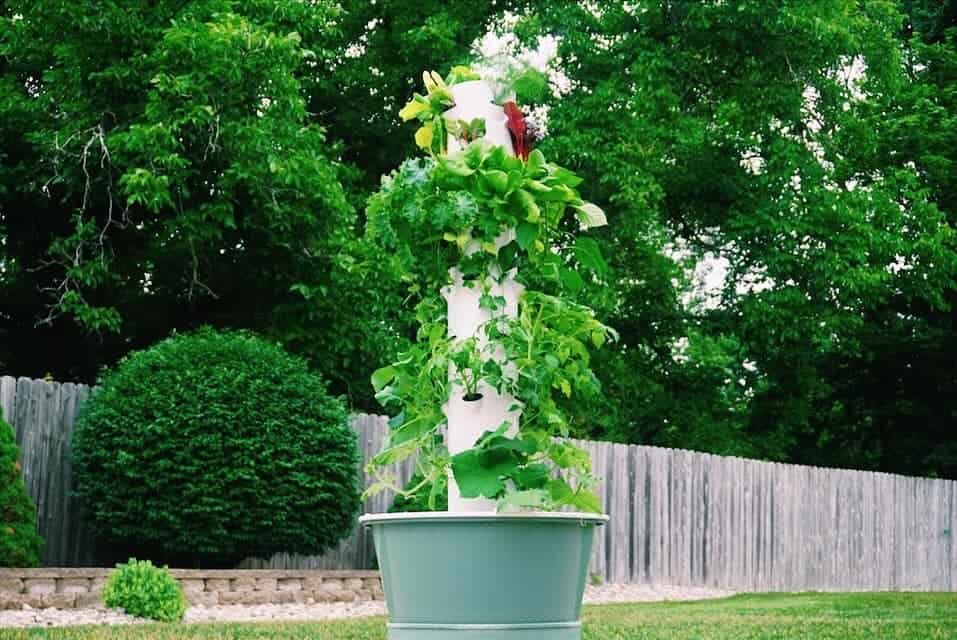
The Gardyn
Gardyn is a hydroponic-based, proprietary system that’s specifically designed for amateurs and fresh-produce enthusiasts as a way to grow their own fruits and vegetables in their own house. Gardyn is WiFi enabled and only requires a 110v outlet and a little water every couple of weeks, which makes it a very simple system to use.
The system uses specialized growing pods with seeds already embedded inside. The pods are ordered from the app and they arrive in the mail with free shipping. Just plug them in and add water to start growing.
Unfortunately, the system doesn’t lend itself to using your own seeds and does have a membership style program to keep you growing with new plants arriving monthly.
The partner app is downloaded on any smartphone or tablet, and the assistant goes by the name of Kelby and pretty much makes the entire system dummy-proof. All you have to do is insert the yCube with the plants you picked out into the tower, pour in some water, and the app does the rest.
Kelby will monitor the plant growth and maturation and manages nutrient distribution, light schedule, and temperature in the closed system. It will even slow down plant growth if you go away on vacation so tell you when the plants are ready to pick and eat.
With Kelby and Gardyn, you can be sure you’re eating fresh, healthy produce that hasn’t been exposed to pesticides or other harmful chemicals, and your kids can watch and learn about plant growth from the comfort of your own home.
As of this writing, Gardyn supports over 30 different kinds of plants, mainly leafy green vegetables like lettuce and spinach and various types of herbs. It only takes up 2 square feet of space as well, meaning it could fit in even a small apartment if needed.
It’s an excellent option for someone who may not have the time or desire to actively manage their vertical gardening system but would still like to grow their own fresh vegetables and herbs.
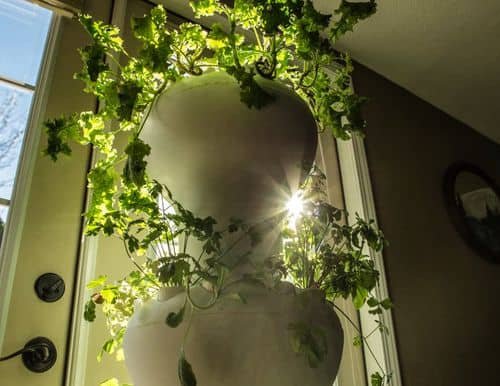
The Foody Vertical Garden
The Foody Vertical Garden tower can actually be considered a hydroponic or a traditional based vertical growing system, since it has configurations for both soil and water-based growth. In order to provide this, it comes in three basic configurations: two hydroponic-based systems of different sizes and made for indoor/outdoor use, and a soil-based system.
They can even be upgraded with a rotational motor and can be purchased with all of the accessories, plants, and growing mediums you might need to get started.
One great benefit of the indoor hydroponic system, the Foody 12, is the ability to grow plants all year round, and the removable net pots that hold the plants make it easy to switch out plants.
No soil is needed, and the water and nutrients that are held in the water reservoir are pumped throughout the system without any human involvement. As long as you place it in a spot in your house that receives plenty of light, the optional rotational motor can ensure every plant on the tower receives enough light.
Sagegreenlife BiotileTM System
While it’s not a garden in the sense that it allows aspiring individuals to grow fresh produce in their house, the Sagegreenlife BiotileTM System is still a fascinating example of vertical hydroponic systems.
Designed primarily for large buildings and for corporate customers who want to make a bold statement with their living walls, the Sagegreenlife BiotileTM System is a professionally installed, customizable plant wall that uses a vertical hydroponic system.
Living walls are a great addition to any space but how long plants last is a common question. Find the answer to this question and more in my article, How Long Do Living Walls Last?
This system’s claim to fame is their BiotilesTM, each of which is easily detachable to allow for work on the internal irrigation systems, as well as responsible for delivering nutrients to the plants it holds.
The Biotiles also allow the system to be highly customizable so that it can be used in a variety of situations to meet the customers’ needs. It helps with noise cancellation, air purity, and environmental sustainability, and can help organizations and buildings attain a variety of environmental and engineering accreditations.
Aeroponic Vertical Garden Systems
Aeroponic systems are very similar to hydroponic systems, but they instead distribute nutrients to roots through flowing water or mist, rather than a water reservoir. Instead of being placed in a medium like in hydroponics, the plant’s roots in aeroponic gardening are suspended in air in a sealed container to keep them moist.
They are sprayed with nutrient-rich mist by a pump attached to a timer. Aeroponics yield much higher yields and better-quality plants over a shorter period of time because the roots don’t need to expend energy on digging through soil and the oxygen rich environment promotes better nutrient absorption.
Aeroponic gardening is actually a subset of hydroponics, since plants aren’t planted in soil but rather have the nutrients exposed directly to the roots as part of a water-based solution. A well designed aeroponic system will work even better than a hydroponic one because the roots are exposed to more oxygen.
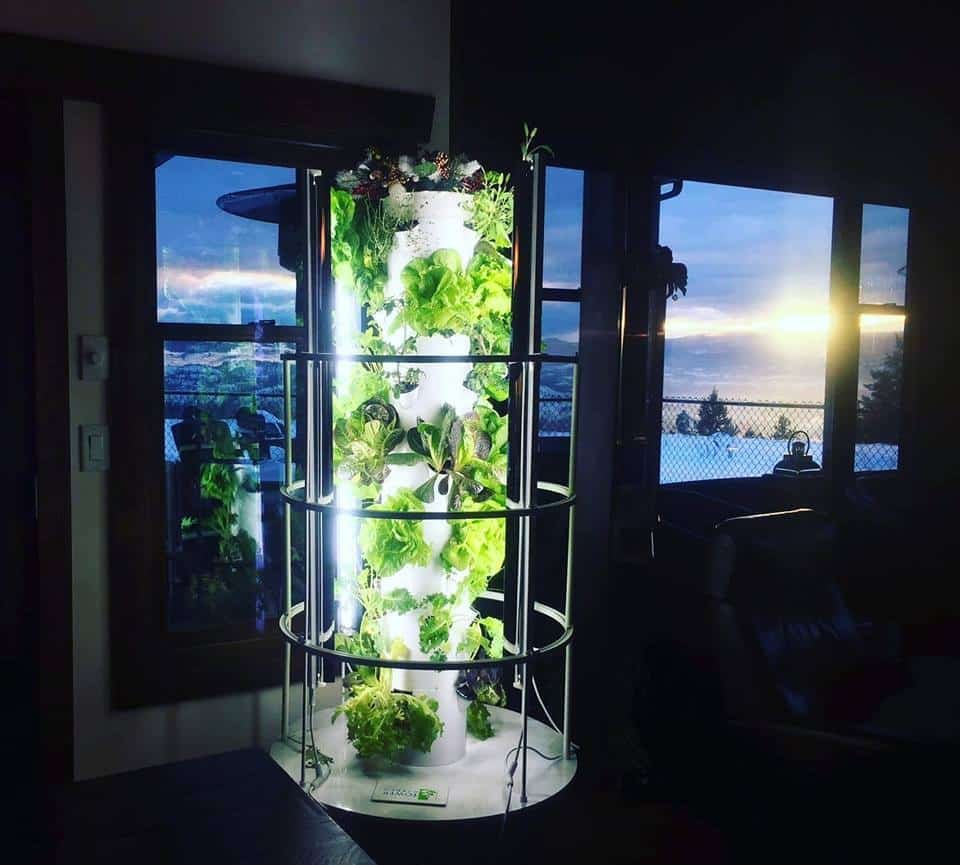
The Tower Garden
Tower Garden is an excellent choice for beginner vertical gardeners, as it’s a very simple system to set up and operate that doesn’t take a lot of space. It’s an aeroponic system, where the plant roots are exposed to the open cavity inside of the tower, and a timer at the bottom pumps a nutrient-rich solution up through the central chamber which showers down on the roots.
There are actually two versions of the Tower Garden, the HOME version (smaller and suitable for indoors), and the FLEX version, which is larger and can be used both indoors or outdoors. Each model only takes up 3 square feet of floor space.
A single tower can grow 20+ plants including fruits, vegetables, herbs and flowers creating a 365 day perpetual harvest at home. The system only has 1 moving part (the water pump) making it very easy to operate and maintain for any skill level.
For more information check out our full length article on What is a Tower Garden and How Does it Work

Tower Garden also supplies their systems to farmers and the agricultural industry under the name Tower Farms. It’s the individual consumer systems on a much larger scale, and they can fit up to 250,000 plants in a one-acre space.
These towers achieve higher yields, faster growth, and less water and fertilizer consumption than traditional farming techniques. As the world’s population continues to grow and space becomes less available, innovative agricultural solutions like Tower Farms will become increasingly utilized.
Aerospring Indoor
Based in Singapore, the Aerospring Indoor is an aeroponic indoor growing system that is entirely self-contained and almost entirely automated. The tower is built in a greenhouse-like enclosure with built-in lighting, which means that plants are kept in the optimal environment to grow quickly.
Nutrients and water are introduced to root systems through an aerosol mist. It takes up less than a square meter in space so it can fit almost anywhere.
Aerospring also makes an outdoor version of the same system, that doesn’t have the same enclosure. This system cannot be grown indoors because it doesn’t provide light to the plants.
Either is an option that’s specifically tailored to beginner gardeners because of how little skill it takes to work, but it can also be used by expert gardeners who are looking for a simpler way to grow fresh produce. It does require electricity in order to function as well as a water hook-up.
Traditional Vertical Garden Systems
As the name suggests, traditional vertical gardening systems use soil and compost as the medium for growing plants. While most of these systems include some sort of nutrient additive for the plants, they have the added benefit of allowing you to cut down on the amount of waste you produce by using organic waste as a composting agent.
While each particular example is different, most of them have a way to place compost in the tower and have a way to distribute the nutrients up through the soil to each plant.
Perhaps one of the most important considerations when installing a soil-based vertical garden system is what type of soil to use. Generally speaking, each type of tower or system will likely have its own soil that it sells with the system, but you can usually just use a good-quality garden soil mix from your local garden supply store. You also need to make sure your soil has sufficient nutrients unless you plan to add compost or a nutrient mix to your soil when you plant.
The benefits of soil-based systems are that they’re generally less expensive than the hydroponic and aeroponic systems, and they allow you to use the compost you generate yourself to give nutrients to the plants.
However, they can be much larger in size and therefore need to be outside, and they often need a lot of extra accessories to be able to function properly. They are much simpler than a more traditional garden plot, so they’re very beginner friendly and can be fun for children to help with.

Garden Tower
One of the leaders in the urban gardener niche, Garden Tower® is a soil-based tower that is capable of growing up to 50 plants. It’s similar in size to the other hydroponic and aeroponic systems on this list, taking up about 4 square feet of space, standing about 43” tall and weighing 220 pounds when filled with soil. It’s billed as the “ultimate patio garden” and is more suitable for outdoor use, though if you purchased special lights for it, you can grow inside as well.
The Garden Tower® is not simply a vertical garden. The center portion of the tower is a special composting container, where you can dump organic waste to decompose. Each plant’s root systems are able to access this compost material, helping ensure they get the nutrients they need.
You can even introduce nightcrawlers to the system to help more efficiently aerate the roots and distribute nutrients throughout the system. You empty the compost material every 90 days and it takes up significantly less volume than before it’s used for the compost.
This system takes a little more work up front than hydroponic systems, and it’s not automated at all by an app or WiFi. However, once the planting is done, most tasks involve watering a few times a week, dumping compost in the center chamber, and emptying old compost and collected water at the bottom of the tower. Even urbanites can enjoy the pleasures of gardening and the fresh produce the Garden Tower® can provide.
Greenstalk
GreenStalk is another soil-based vertical gardening system that uses a series of circular, interlocking trays to grow plants. It even has rolling casters on the bottom to allow for moving it around a small apartment or office space, and is much more suitable for indoor use than the Garden Tower®.
It uses a gravity-based watering system, so all you have to do is water the top-most tray and the water and nutrients will filter down through the rest of the plants.
Greenstalk can support up to 30 different plants. All you need to get started is some high-quality, loamy-based potting soil and whatever seeds or starter plants you want to use. This is a nice feature in comparison to hydroponic systems, which often require you to purchase their proprietary growing medium and their own plants, which makes them more expensive.
Greenstalk also has a robust and helpful online community dedicated to helping other vertical gardeners get the most out of their product.
Closing Thoughts
Vertical gardening is an excellent way for anyone, living anywhere, to grow their own fresh produce at home. It has almost too many benefits to count – it allows you to save money on produce, it’s simple enough for beginners to be able to master easily, it saves space, it’s fun for kids, and it allows you to be sure that your produce is fresh and hasn’t been doused in chemicals or pesticides.
It’s especially well-suited to urban gardening, where its space-saving features make the systems able to be used in a small apartment or an outdoor balcony.
Whether you choose hydroponic, aeroponic, or traditional vertical gardening systems, you’ll find a number of trade-offs and benefits unique to each. Hydroponic and aeroponic systems are similar to each other, and both are more expensive to purchase and maintain than traditional systems.
Traditional systems are less expensive, but also require more time invested and more upkeep, as many hydroponic and aeroponic systems are almost fully automated. Any of the systems mentioned above, however, are viable options for someone interested in growing more of their food at home, increasing their self-sufficiency and ensuring they have fresh produce (in some cases, year-round).
